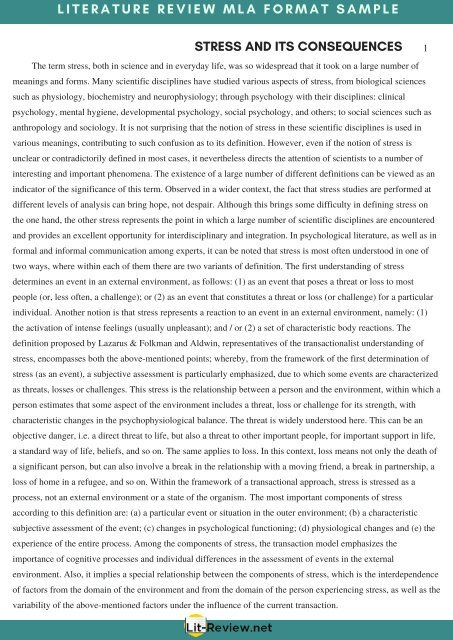Astonishing Sample Literature Review MLA Format
How to get the best astonishing sample literature review MLA format. Geth this info here http://www.lit-review.net/mla-literature-review/
How to get the best astonishing sample literature review MLA format. Geth this info here http://www.lit-review.net/mla-literature-review/
You also want an ePaper? Increase the reach of your titles
YUMPU automatically turns print PDFs into web optimized ePapers that Google loves.
L I T E R A T U R E R E V I E W M L A F O R M A T S A M P L E<br />
STRESS AND ITS CONSEQUENCES 1<br />
The term stress, both in science and in everyday life, was so widespread that it took on a large number of<br />
meanings and forms. Many scientific disciplines have studied various aspects of stress, from biological sciences<br />
such as physiology, biochemistry and neurophysiology; through psychology with their disciplines: clinical<br />
psychology, mental hygiene, developmental psychology, social psychology, and others; to social sciences such as<br />
anthropology and sociology. It is not surprising that the notion of stress in these scientific disciplines is used in<br />
various meanings, contributing to such confusion as to its definition. However, even if the notion of stress is<br />
unclear or contradictorily defined in most cases, it nevertheless directs the attention of scientists to a number of<br />
interesting and important phenomena. The existence of a large number of different definitions can be viewed as an<br />
indicator of the significance of this term. Observed in a wider context, the fact that stress studies are performed at<br />
different levels of analysis can bring hope, not despair. Although this brings some difficulty in defining stress on<br />
the one hand, the other stress represents the point in which a large number of scientific disciplines are encountered<br />
and provides an excellent opportunity for interdisciplinary and integration. In psychological literature, as well as in<br />
formal and informal communication among experts, it can be noted that stress is most often understood in one of<br />
two ways, where within each of them there are two variants of definition. The first understanding of stress<br />
determines an event in an external environment, as follows: (1) as an event that poses a threat or loss to most<br />
people (or, less often, a challenge); or (2) as an event that constitutes a threat or loss (or challenge) for a particular<br />
individual. Another notion is that stress represents a reaction to an event in an external environment, namely: (1)<br />
the activation of intense feelings (usually unpleasant); and / or (2) a set of characteristic body reactions. The<br />
definition proposed by Lazarus & Folkman and Aldwin, representatives of the transactionalist understanding of<br />
stress, encompasses both the above-mentioned points; whereby, from the framework of the first determination of<br />
stress (as an event), a subjective assessment is particularly emphasized, due to which some events are characterized<br />
as threats, losses or challenges. This stress is the relationship between a person and the environment, within which a<br />
person estimates that some aspect of the environment includes a threat, loss or challenge for its strength, with<br />
characteristic changes in the psychophysiological balance. The threat is widely understood here. This can be an<br />
objective danger, i.e. a direct threat to life, but also a threat to other important people, for important support in life,<br />
a standard way of life, beliefs, and so on. The same applies to loss. In this context, loss means not only the death of<br />
a significant person, but can also involve a break in the relationship with a moving friend, a break in partnership, a<br />
loss of home in a refugee, and so on. Within the framework of a transactional approach, stress is stressed as a<br />
process, not an external environment or a state of the organism. The most important components of stress<br />
according to this definition are: (a) a particular event or situation in the outer environment; (b) a characteristic<br />
subjective assessment of the event; (c) changes in psychological functioning; (d) physiological changes and (e) the<br />
experience of the entire process. Among the components of stress, the transaction model emphasizes the<br />
importance of cognitive processes and individual differences in the assessment of events in the external<br />
environment. Also, it implies a special relationship between the components of stress, which is the interdependence<br />
of factors from the domain of the environment and from the domain of the person experiencing stress, as well as the<br />
variability of the above-mentioned factors under the influence of the current transaction.





